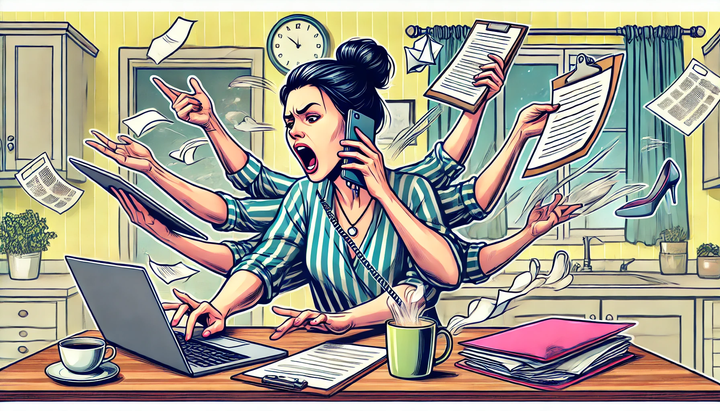How to Have More Effective Meetings - Part 2: Process and Product
Once you know your Purpose and People, you can nail down how you will run the meeting (Process) and what you will produce from it (Product)!

In my last article, How to Have More Effective Meetings - Part 1: Purpose and People, I covered the first two of the 4Ps of meeting.
Now we are getting into the last two of the 4Ps of meetings: Process and Product. Let’s dig in!
Process: How is the meeting run?
Once you know why you are meeting, the Purpose, and who should be there, the People, you need to set the meeting up for success with some Process.
Your meeting Processes are all the things you need to do to:
- Get yourself prepared
- Get the people attending prepared
- Set clear expectations
- Keep continuity between meetings
The number one thing you can do to set your meeting up for success is create an agenda and send it to your attendees ahead of the meeting.
A good rule of thumb: No Agenda, No meeting
Almost all formal meetings should have an agenda. Full stop.
Why? Preparing an agenda helps you:
- Get clarity on the purpose of the meeting and the outcomes you want to drive to because you have to articulate them.
- Determine if the meeting is truly necessary (or if it should just be an email!).
- Have something to send to your attendees that sets expectations for what will happen in the meeting and how they can prepare.
You never want people to come into a meeting cold because it means they are unprepared and you spend valuable time explaining why the meeting is happening instead of getting right into it.
Sending the agenda ahead of the meeting also helps prevent people from having to say, “I need to look into that” or “I will get back to you on that” because they should already have known what was going to be asked of them and prepared accordingly.
“I don’t have enough time to write an agenda for every meeting” (... is a lie)
My response to you, if you think you don’t have enough time to prepare an agenda for a meeting, is: if you have enough time to meet, you have enough time to prepare the agenda.
Preparing and sending an agenda (your Process) is an investment in the success of the meeting. It’s not about having “enough time” but rather what you prioritize. When you don’t prioritize preparing for the meeting, you waste even more time because no one is prepared.

What makes a good agenda?
What makes a good agenda is a topic I have spent a long time on because my software company built agenda and meeting minute software, Tadum! In my illustrious opinion, a good agenda has some combination of the following sections:
- Todos: What did people say they would do? Who said they would do it? When will it be done?
- Attachments: Any information that should be reviewed before the meeting, including general updates and the previous meeting minutes.
- Discussions: These are the purpose statements and the meat of the meeting. What are you meeting for?
- Updates: On action items from the last meeting, not updates on all things. Only answering: Is it done and if not, what’s the blocker?
- Metrics: Anything you are tracking and measuring.
You will notice the first letter of each of these spells TADUM… the acronym we named our app!
You don’t need to have all of these sections, and in fact, likely won’t, but you will always have Todos and Discussions!
You don’t need an app to make a good agenda! A simple Word or Google Doc will do the trick. Make it easier on yourself and your team by creating templates for each of your recurring meetings. Be it your weekly team meeting, quarterly strategy sessions, or 1-on-1s (or any regular meeting), start with a template, like this Agenda Template Example.
A few other sections you can add to an agenda to make it good:
- Tabled/Parking Lot: Items that came up for discussion but are lower priority and should be bumped to a future meeting.
- Bonding: This might be setting aside time at the beginning of the agenda to share good news, highs and lows, or time at the end to do a one-word or phrase close to describe how you feel after the meeting as a check-in.
Agendas help keep you on time and on topic during the meeting
A meeting without an agenda is like travelling to an unfamiliar destination without a map (or the Google Maps voice telling you where to go). You might get there, but it will take much longer than it needs to, you will end up in places you didn’t want to, and everyone will be frustrated and tired.
Your agenda acts as your meeting map. It sets the route for the conversation and gives you something to refer to if you start to veer off course. It’s a tool for you to keep your meeting on time and on topic.
Other ways you can use your agenda to stay on time and on topic:
- Set time estimates for each topic so as you work through each agenda item you can be sure you make it to all the topics you want to talk about.
- Organize the agenda with the most important items first. If you need extra time on those topics, you can reprioritize the later items to future meetings.
- Bump off-topic discussions to future or separate meetings by saying something like, “This is a great conversation and I want to continue it, but I would like to get back to our original agenda. Let’s note this discussion for the next meetings agenda”.
Do you know anyone who might like this article? Share it!
Product: What did you produce/what’s next?
The final P of the 4 Ps of Effective meetings is Product. When you have finished the meeting, what do you have to show for it?
- What did you produce?
- What decisions were made?
- What ideas were brainstormed?
- What actions were decided
- Who said they would do what and when?
At a minimum, every meeting should have at least one product: meeting minutes. The minutes are the de facto record of what happened.
Because, if there are no meeting minutes, did the meeting really happen?! 😁
Record meeting minutes to keep a history of what you produced
Humans have notoriously bad memories. I don’t know about you, but I don’t remember what I did last week, never mind what was discussed in a meeting several months ago.
The good news is that you don’t have to remember if someone wrote it down!
Keep a history of discussions. This is helpful when you need to look back on
- What decisions were made
- Why they were made
- Who was involved
It also gives you something to reference for project post-mortems and also information to send to people who couldn’t attend the meeting.
Record meeting minutes to keep people accountable between meetings
Nothing is so common as having someone agree to do something in a meeting, only to forget it the moment they walk out as their minds move on to the next order of business.
Keep people accountable between meetings. When you write down action items and todos, who said they would do them, and when, you have fewer situations where you walk into a meeting and nothing has been done. It sets the expectation that action items and todos will remain on the agenda until they have been finished and be revisited in future meetings.
At every meeting:
- Assign a note taker to record your meeting minutes at each meeting. They can be a consistent person or a volunteer. The important thing is that they record options, decisions, and actions, send the minutes out after the meeting, and store them in an easy-to-access place for anyone who needs to read them.
- Record every action item with a person responsible and a due date. It's not enough to write something down. You have to have someone take responsibility for doing it and set a timeline for when they will have it done.
- Review action items from the previous meeting at the beginning of each new meeting. Don’t have long discussions about them, just ask if it was done, yes or no. Sometimes things get missed or are reprioritized. If someone doesn't do something for 2 meetings in a row, you then have a decision point. You can ask: Is it a priority and are they the right person to do it?
- Send the minutes to everyone, especially people who couldn’t attend the meeting. This helps keep everyone updated and in the loop to save time at future meetings.
If you don’t write it down, it won’t get done!
Meetings have a bad reputation because they are so often approached with a complete lack of intention. As you have learned through this article and my previous article, How to Have More Effective Meetings - Part 1: Purpose and People, there are several pieces that need to come together to make sure that the meetings you call and the meetings you attend are effective and good use of everyone’s time.
Meetings don’t have to be terrible! A bit of intention, thoughtfulness, and effort will go a long way. Next time you call a meeting, make sure you go over the 4Ps:
- Purpose: Why am I calling the meeting?
- People: Who needs to be there?
- Process: What am I doing to make sure everyone is prepared?
- Product: What did we produce from the meeting?
If you can answer all of those, you are well on your way to an effective meeting!
Want to have more effective meetings in your organization? I teach this as a learning session! Reach out to chat about having me speak to your team.
Share
Ashley Janssen

Productivity consultant, writer, speaker, serial entrepreneur, chaos calmer, introvert, cat-lady. Lover of books, fitness, old fashioned’s, basketball, and video games.
Follow me on
Twitter
or
LinkedIn.
Hire me for
1 on 1 productivity consulting
or
speaking.
Related articles

When You Do Things Matters

What If Being Lazy Was a Good Thing?


Comments ()